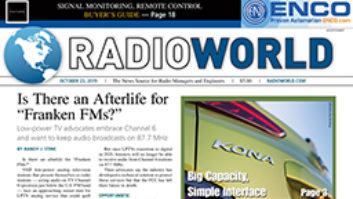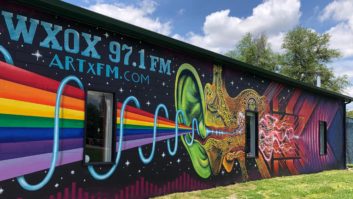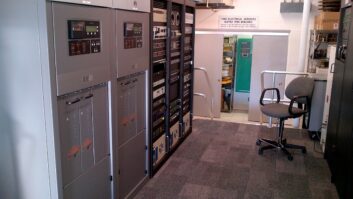Is there an afterlife for “Franken FMs”?
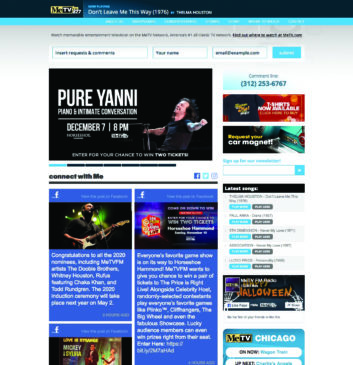
VHF low-power analog television stations that present themselves as radio stations — airing audio on TV Channel 6 spectrum just below the U.S. FM band — face an approaching sunset date for LPTV analog service that could spell their doom.
Advocates argue that many FM6 stations provide important audio services to supplement their video signals and that “millions” of Americans tune to 87.7 FM to listen to programming not available anywhere else, particularly in ethnic and minority communities that are underserved. The very term Franken FM, they add, is a pejorative one coined by radio stations that fear additional legitimate competition.
But once LPTVs transition to digital in 2021, listeners will no longer be able to receive audio from Channel 6 stations on 87.7 MHz.
Their advocates say the industry has developed a technical solution to protect these services but that the FCC has left their future in doubt.
OPPORTUNISTIC
The audio carrier for TV Channel 6 can be heard on many car and tabletop FM receivers. Opportunistic low-power licensees use their TV transmitters to air separate audio and video content, according to those familiar with the practice. FM6 stations are programmed as radio stations, though they are still required to transmit a TV signal, sometimes merely travelogues or nature scenes, in other cases more useful information like visual traffic and weather. The TV signal is analog, “so no one is watching them,” according to one observer.
The stations can operate this way thanks to a loophole opened when the FCC created the LPTV rules, as Radio World has reported. FM6 stations operate in a number of major cities; there are approximately 30 presenting themselves as FM stations in the United States. They were nicknamed Franken FMs by broadcast engineers who were aware of the practice early and considered the signals to be, like Frankenstein’s monster, an unnatural mashup.
As controversial as the practice might appear, legal analysts say the LPTV licensees are working within FCC regulations, though critics feel the practice was not what the FCC had planned when crafting LPTV rules.
Until the 2009 digital transition, full-power TV stations could be heard on that part of the dial; but most audio signals at 87.7 FM have since disappeared.
FM6 operators want to continue to provide analog carriers in order to reach FM radios after the LPTV analog sunset date. That sunset has been extended several times, giving FM6s a longer life than expected. However, the FCC is not believed to be considering another extension.
“NO TECHNICAL BARRIER”
According to the LPTV Spectrum Rights Coalition, operators are continuing to work on technical solutions to provide maximum performance without causing impermissible interference.
“There is no technical barrier to allowing TV Channel 6 FM operators to continue after the July 13, 2021, LPTV analog sunset date,” said Mike Gravino, director of the Washington-based group.
“Remember, it is all about highest and best use of spectrum; and 87.7 FM is available in all markets, can be heard by most car radios and should be used as much as possible.”
The Preserve Community Programming Coalition (PCPC), a group of FM6 broadcasters, has asked the FCC to permit LPTV and TV translator stations on analog Channel 6 to supplement their future digital LPTV operations with a small analog audio carrier.
“This will allow listeners to continue receiving analog audio programming on 87.7 FM without disrupting the ATSC-compatible digital transmission using the majority of the 6 MHz channel,” said Ari Meltzer, a communications attorney with Wiley Rein LLP, representing PCPC and spearheading talks with the FCC.
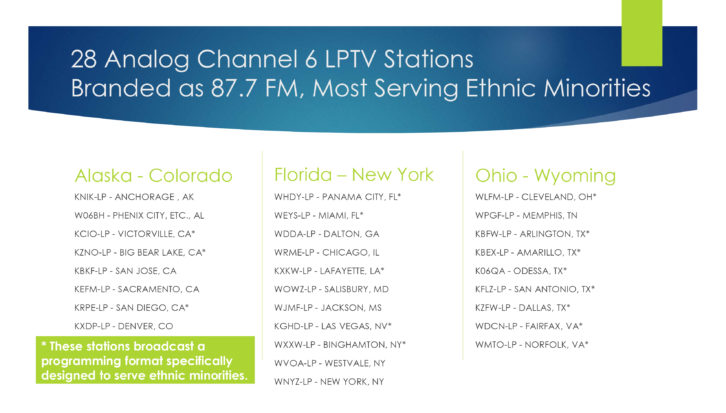
The goal of the group is not to extend the analog deadline, Meltzer said, but to allow existing Channel 6 FM broadcasters to continue delivering valuable and diverse audio programming that can be received on 87.7 FM following the digital transition.
PCPC estimates that approximately 50 LPTV and TV translator stations are authorized to broadcast an analog signal on Channel 6, more than half of which provide a separate audio stream for reception on 87.7 FM.
The group says analog Channel 6 LPTV radio stations on the air include KRPE(LP) in San Diego, WNYZ(LP) in New York City, WRME(LP) in Chicago and KZFW(LP) in Dallas.
It says that WRME in Chicago has outperformed several traditional AM and FM stations in several ratings categories; that Guadalupe Radio in southern California is an important Christian voice; that WDCN is the second largest Hispanic radio station in the D.C./Maryland/Virginia area; and that KXDP is the only station in Denver that broadcasts live news, traffic and weather reports in Spanish.
Audio from an analog carrier on 87.7 FM and Channel 6 DTV can coexist on the same channel, according to the PCPC presentation to the commission. “An 87.7 MHz audio signal can coexist on the same 6 MHz channel as a digital Channel 6 LPTV station without harming TV or FM reception.”
The group’s ex parte filing stated that “a television station typically utilizes 5.38 MHz of its 6 MHz channel to broadcast a digital signal. The unused 0.62 MHz can be used to transmit a supplementary audio signal.”
A chart from the group indicates that by “slightly narrowing the bandwidth used for the DTV broadcast on Channel 6, it is possible to insert an FM audio carrier at 87.76 MHz without degrading the DTV signal or derogating the ability of ATSC tuners to receive it.”
Meltzer said the PCPC is not proposing a shift in analog audio from 87.75 to 87.76 MHz. The exact placement of the audio carrier is less important than the fact that this is a proven concept consistent with the FCC’s rules, which do not require full compliance with the ATSC standard for digital LPTV stations, Meltzer said.
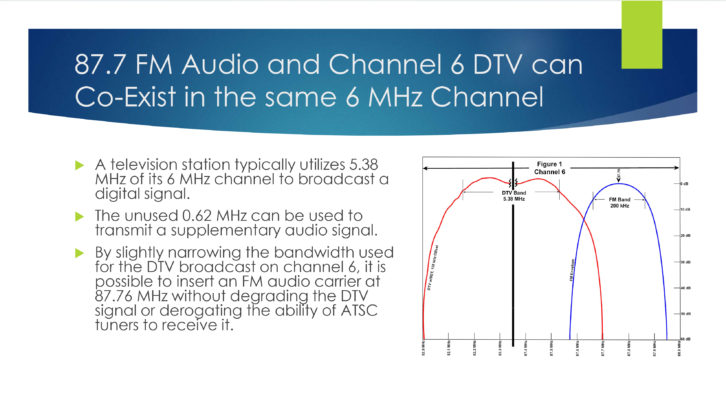
“Procedurally, the FCC already has a full record on allowing digital LPTV stations operating on Channel 6 to add an analog audio carrier. The PCPC is merely asking the commission to clarify that the analog sunset rules do not prohibit the broadcast of a supplemental analog audio carrier when existing Channel 6 FM stations transition to digital,” Meltzer said.
According to the FCC, its records indicate there are no digital LPTV Channel 6 stations operating with an analog audio carrier at 87.75 MHz.
UNCERTAINTY
LPTV Channel 6 advocates say the commission’s “failure to address questions raised by its 2014 NPRM raises uncertainty about the future of these stations.”
In 2014, the Media Bureau released an NPRM seeking comment on whether digital LPTV stations should be allowed to operate analog FM radio type services on an ancillary or supplementary basis. At the time National Public Radio voiced opposition to the changes.
The FM6 advocates say there is no evidence that a Channel 6 TV station, operating within lawful parameters of its license, causes harmful interference to an FM radio station.
LPTV stations do not have codified rules to protect FM facilities in the reserved band (87.9-91.9 MHz), according to legal observers. And LPFMs are required to protect LPTV (and thus FM6) stations. In addition, FM translators must protect Channel 6 stations.
Since TV Channel 6 is adjacent to the noncommercial portion of the FM band, which runs from 88.1 to 91.9 MHz, there are interference concerns for some observers.
“If the FCC legitimizes Franken FMs, the TV6 radio operators need to follow the same rules applicable to radio, and protect adjacent NCE stations from incoming interference,” said Melodie Virtue, a communications attorney with Foster Garvey.
There currently are no interservice (TV-FM) protection requirements, Virtue said.
“LPTV, as secondary, needs to protect full-power NCEs. There should be protection in favor of the NCE full-power radio stations from FM6 audio stations if those are allowed to continue to exist after the LPTV digital transition deadline.”
PROTECTED CONTOURS
Data collected by REC Networks, an LPFM advocate, appears to support FM6 broadcasters’ argument that interference between FM6s and noncommercial broadcasters is not a concern.
REC told Radio World it has evaluated the service contours of all of the FM6 stations mentioned in PCPC’s ex parte comments. “We found that most of the service contours where those FM6 stations are, there is already a protected contour of a NCE FM station on 88.1 or 88.3 MHz,” said Michi Bradley, founder of REC Networks. “If there is any actual interference from a FM6 station to full-service broadcasters, existing NCE FM stations would already know about it.”
In a related matter, the FCC this year released a Notice of Proposed Rulemaking (MB docket 19-193) that could affect the LPTV FM6 stations. The NPRM, based on a petition from REC Networks, proposes to improve technical rules that primarily affect LPFM stations.
In it the FCC reaffirms the sunset date for LPTV analog transmissions. But the NPRM also states: “REC concludes (in its petition) that the LPFM rules significantly over-protect TV6 stations and could be reduced with little impact … REC supports but is not proposing a complete repeal of TV protection requirements.”
The FCC further proposes “to provide LPFM stations relief from television 6 protection rules and to eliminate TV6 protections entirely on July 13, 2021, and propose to institute a waiver process in the interim, i.e., as of the effective date of any new rule adopted in this proceeding and before July 13, 2021.”
Industry voices, like NAB, have long been guarded in comments about FM6 stations. NAB declined comment for this story.
Comment on this or any story. Email radioworld@futurenet.com with “Letter to the Editor” in the subject field.
